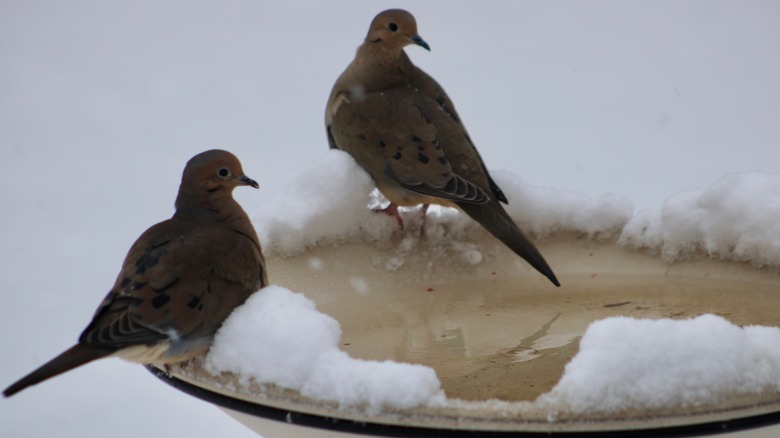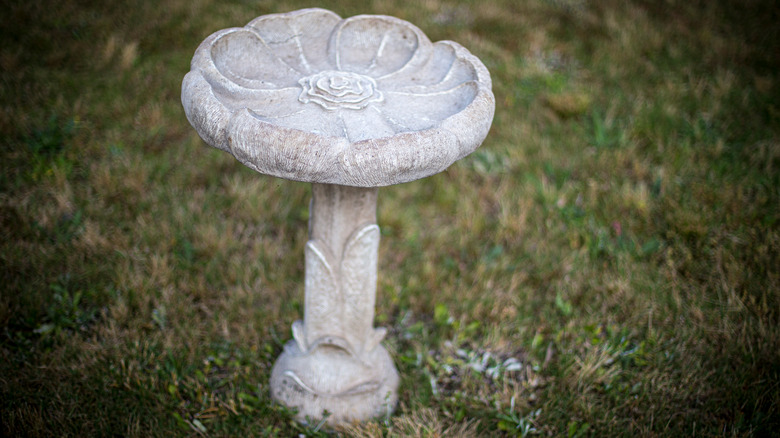We may receive a commission on purchases made from links.
During the winter, it can be difficult for birds that don’t migrate to find water that hasn’t frozen over, and melting ice just for a small drink will require your feathered friends to use a lot of energy. Keeping your birdbath active all year long is a great way to help these animals survive harsh winter conditions, but it’s important to consider the material your bath is made of. While some birdbaths can be used throughout the winter season without issue, other materials cannot tolerate extremely cold weather.
Ceramic, stone, concrete, mosaic, and glass birdbaths can expand in freezing temperatures, which can cause damage like cracking. On the other hand, birdbaths made of plastic, metal, or resin aren’t typically damaged by harsh weather and can be used throughout winter to provide your feathered friends with fresh water. At the same time, if you live in an area that does not experience at or below freezing temperatures, you won’t need to worry about what type of bath to use or how to maintain it other than keeping it clean, as it likely won’t become cold enough outside to damage your bath.
Types of birdbaths to use in the winter

Resin and plastic birdbaths are often used during freezing weather because they won’t crack like some other materials and are less likely to break if you need to remove ice from them. Metal is also suitable, as it shouldn’t be damaged by the cold either. Even though plastic, resin, and metal baths can handle winter temperatures, the water inside will still freeze unless measures are taken to keep it in liquid form. When purchasing a bath specifically for winter, you may want to consider buying a heated birdbath, like the Farm Innovator’s 70-Watt Birdbath from Walmart for under $70 or the Sunvigor Deck-Mounted 75-Watt Heated Birdbath that costs about $40 on Amazon, if your budget allows. Simple birdbath heaters and deicers, like this Lollyes 70-Watt Heater from Amazon that’s priced at about $20, can be added to the bath you already have and are another convenient and easy way to keep the water from freezing.
If you can’t get a heater, try pouring warm water into the bath often, which can help keep the temperature above freezing. Relocating your birdbath to an area of your yard that gets a lot of sunlight can help prevent the water from freezing as quickly, and putting it beside a tall tree or fence will block the wind, therefore keeping the water warmer. Placing a tennis ball in your birdbath will also help break up small layers of ice as they form.
How to overwinter your birdbath

If you have a birdbath that’s made out of a material that could be damaged by bitter weather, you’ll need to prepare it for cold temperatures or put it away until spring. It’s best to empty stone, concrete, glass, and other birdbaths that could be susceptible to damage. After they’re emptied, you can clean the baths before storing them for the winter season. For those with garages or sheds, your birdbath could be kept safely inside until spring arrives.
If you don’t have a sheltered place to keep your bath until the weather warms up, leave it upside down outside during frigid temperatures. This will help to prevent water from pooling inside, freezing, expanding, and cracking your birdbath. For baths that are too heavy to be moved or are fixed in one spot, cover them with a tarp or other waterproof material to keep moisture out. Though you might have to decommission your beautiful, decorative birdbath for the winter, it is still helpful to leave out a plastic dish that’s filled with water for your feathered friends.



